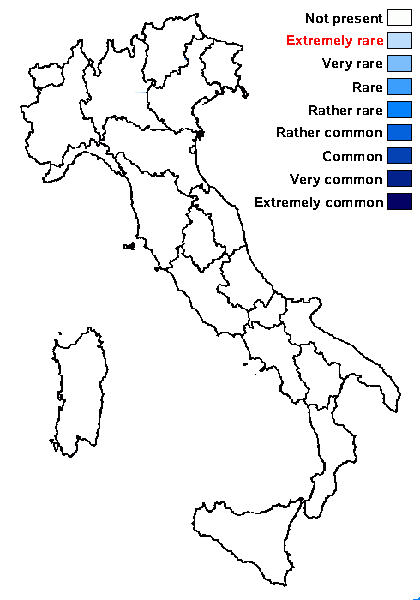Elixia cretica T. Sprib. & Lumbsch
Lichenologist, 42: 368, 2010
Synonyms:
Distribution:
Description: Thallus crustose, episubstratic, areolate to rimose-areolate, <50 μm thick; areoles 0.4-0.5(-0.6) mm wide, brown to greenish in sheltered situations, matt. Apothecia lirelliform, at first relatively simple, with 2-3 ends and a concealed disc, later star-shaped with up to 7 rays and with an exposed, dark brown disc, the largest ones 0.5-1.4 mm across, the proper margin jet black, matt, projecting above disc, often appearing inrolled. Proper exciple 15-20 μm wide, dark brown to nearly carbonaceous, paraplectenchymatous; epithecium dark brown; hymenium colourless to pale yellow, 55-60 μm high, hemiamyloid, I+ deep rusty red, K/I+ blue; paraphyses coherent, mostly simple, 1.5-2 μm thick ad mid-level, the apical cells 3-5 μm wide, with dark brown pigment inclusions combined with a diffuse brownish pigment; hypothecium occupying a narrow zone between exciple and hymenium, consisting of light brown or reddish brown, paraplectenchymatous cells, up to 10 μm high. Asci 8-spored, cylindrical to clavate, K/I+ blue, with a light amyloid tissue throughout, but with darker staining regions around the apex and in a narrow zone below the inner upper wall of tholus. Ascospores 1-celled, hyaline to faintly brown, broadly ellipsoid, (7-)8-10 x 3.2-4.5 μm, not halonate. Photobiont chlorococcoid. Spot tests: thallus K-, C-, KC-, P-, UV-. Chemistry: without lichen substances.
Note: a recently-described species, known only from Crete, on the bark of Pinus brutia at 1125 m. To be looked for in the mountains of Southern Italy.
Growth form: Crustose
Substrata: bark
Photobiont: green algae other than Trentepohlia
Reproductive strategy: mainly sexual

Predictive model
Growth form: Crustose
Substrata: bark
Photobiont: green algae other than Trentepohlia
Reproductive strategy: mainly sexual

Predictive model
 INDEX FUNGORUM
INDEX FUNGORUM
 GBIF
GBIF


